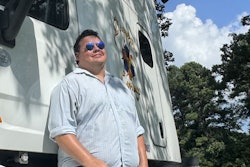Blues performer Watermelon Slim quit driving a truck in 2004 to pursue music full time with his band, The Workers.
Aspiring musicians in the trucking industry are common, but the guys who actually make it are lucky and few.
Blues man Bill “Watermelon Slim” Homans, who most people just call “Slim,” is both a new and old voice on the blues scene. His new album, Watermelon Slim and the Workers, is his third album in four years, following the success of the 2003 release Up Close and Personal. At 56 years old, Slim is experiencing late success in his musical career with critically acclaimed albums, a rockin’ band, The Workers, and a past full of stories from Vietnam, truck driving, and the marriage of a slide guitar and a gravelly voice.
“I’m thankful to have my musical career, as late in life as it is,” Slim says.
Born in North Carolina, Slim remembers the family maid singing old John Lee Hooker songs, especially “One Bourbon, One Scotch, One Beer.” But it was only many years later when he realized that the music he had grown up with was actually blues, a passion that, along with truck driving, fueled his desire to make his music known to the world.
In 1969, Slim began truck-driving training for the military, but he didn’t receive his commercial license until 1980. In an Army hospital in Vietnam, Slim taught himself how to play the left-handed slide guitar. He released his first album in 1973, an underground album to protest the Vietnam War, but then turned to truck driving for a living.

He hauled produce until 1984, and a short stint in watermelon farming gave Slim the name that granted him entry into the club of nicknamed bluegrass and blues pickers. He attended the University of Oregon for a degree in journalism and history, but in 1987 he was back on the road, working for a moving company in Boston after his music career failed in Europe. Then he got married to a woman he calls “the best spoons player in Massachusetts,” and in 1992 while he was driving for Werner, his daughter was born.
Slim earned a master’s degree at Oklahoma State University in 2000 and continued to work on his music with top names in blues like Chicago harp player “Earring George” Mayweather, Bonnie Raitt and John Lee Hooker.
A heart attack in 2002 only slowed Slim down for a little while.
After recovering, he got back to driving a truck and making music. He released the album Big Shoes to Fill and traveled all over the country, performing and gaining fans.
In 2004 Slim gave up trucking to focus on his music, and in 2005 he won the W.C. Handy Award for Best New Artist Debut, and his album Up Close and Personal was named the No. 1 Southern Blues CD of the Year. Decades of hard work have paid off, and with the release of his new album, Slim is looking forward to future success.
So far, his favorite stop on tour has been England in 2004. After years of college between trucking, he can enjoy putting his knowledge to good use as a tourist.
“I’m a big Shakespeare buff, and I got to reach out and touch his bed [while I was in England],” Slim says. “My book of Shakespeare is broke down in the bindings.”
Despite Slim’s highbrow taste in literature, the twang of his guitar and lyrics like, “If you got nine speeds forward, you better grab for number 10/ Cause I’m hammer down and high-ballin’, you might never see my face again,” in his song “Mack Truck,” remind fans of his trucking roots.
“This is the music that they can identify with,” Slim says.
Slim lives in Oklahoma now, but for New Year’s Eve 2006, a company of chicken haulers asked him to drive a “tricked out Peterbilt” around the block as a promotion for a gig at Knucklehead’s in Kansas City.
“It was so cool, man,” he says. “I loved it.”
He then went in and joined the band for a late-night jam.
As his musical career heats up, Slim is quick to remind fans that the highway is one of the greatest influences of his music.
“Working has taught me more about life than anything else,” he says. “But I’ve always thought of trucking as a public service. I retain a great deal of pride about it.
“I always keep my CDL current.”
Check out Watermelon Slim’s website and blog about his travels on the road at this site.
-Rachel Telehany
BREAKING RECORDS, RAISING FUNDS
World’s Largest Truck Convoy to benefit Special Olympics
On Sept. 16, 2006, stretches of highway throughout North America will be lined with an expected 4,000 trucks as they convoy to show support for the athletes of the Special Olympics and attempt to maintain status as the World’s Largest Truck Convoy in the Guinness Book of World Records.
An international event, the truck convoy is a partnership between law enforcement and truckers to raise money and awareness so that Special Olympics athletes can continue to train in year-round sports activities.
This year’s convoy is expected to unite more than 4,000 truckers in 34 states and Alberta and Ontario, Canada, and raise nearly $600,000. In 2005, the event attracted nearly 1,800 truckers and raised $439,309.
The idea for the event was conceived in 2001 by Cpl. Norm Schneiderhan, a special project coordinator for the Orange County Sheriff’s Office in Florida. Schneiderhan, who drove a truck for his father’s trucking company before becoming a police officer, wanted to call truckers’ attention to the Special Olympics.
Founded in 1968, Special Olympics promotes understanding, acceptance and inclusion among people with and without disabilities. Through year-round training and athletic competition and other related programming, the organization provides 2.25 million children and adults with disabilities in more than 150 countries with opportunities to develop physical fitness and friendships.
Trucking companies and drivers who want to participate in this year’s event can get more information and a registration packet at this site. The minimum donation to participate in the convoy is $100 per truck. Trucking companies can bid additional sponsorship funds to win the leading spot in the convoy.
To learn more about the Special Olympics visit this site.
–Brittani Tingle
ONE MAN, BIG IMPACT
Former trucker pioneered new methods of surgery
In the Army train on the way to Fort Louis, Wash., drafted soldier James Crudup started to feel sick.
An unsettling feeling hung in his stomach like a weight, and as the trip wore on, he felt worse. Nausea set in and he hunched over, clutching his stomach and closing his eyes. They let him out in Chicago to be treated for food poisoning, and when he finally arrived in Fort Louis, the doctor gave him a discharge from the Army for what he called a “nervous stomach.”
Little did that doctor know, the man with the so-called “nervous stomach” would one day pioneer microsurgery and change the way surgeons operate.
When Crudup was discharged in 1945, he returned to his home in Forest, Miss., to finish high school and look for work. His life, like any country boy’s, was mostly spent fishing and swimming with his three sisters and two brothers, and helping his father haul wood and tend the family’s small garden.
“Everybody in the South those days had a garden,” he says.
In the 1940s, many people still lived too far in the country to go to school, so Crudup and his brothers hauled people in from the rural areas to attend the only area high school. After graduation, Crudup stayed in Forest, raising chickens and working at the lumber mill, making plans to pursue a career as a mechanic.
But in 1951 Crudup moved to Michigan with his brother-in-law and sister to look for work, as many folks in the South did at the time.
He settled in the suburbs of Detroit and drove for the Clipper Brick Company, delivering common brick, which is made by putting clay into a mold and then shaping it with a compressor. He worked there for eight years in the freezing Michigan weather, far away from his boyhood home of Mississippi.
When the company went out of business in 1959, Crudup found a job in a chemistry lab at the University of Michigan.
Every day, the former truck driver cleaned beakers and pipettes, wiped off the counters, swept and mopped the floors, and turned out the light at the end of the day. One day, Dr. Gardner Childs noticed his careful work and sent him to watch residents perform surgery on small animals for research. Crudup watched orthopedists, urologists and cardiologists perform intricate procedures with minute tools, and he began studying their methods.
“Any time an animal surgery was performed, I would scrub in to assist and learn,” Crudup says. “I would even take the animals before they went to the incinerator and do my own exploratory surgery.”
Wearing highly sophisticated glasses that allow the wearer to see in small detail, Crudup studied and performed liver, kidney and heart transplants on small and medium-sized animals.
Soon, Crudup became so skilled at the instruments and procedures used in surgery that Dr. Childs sent residents to him to learn. Dr. Childs eventually set up a research lab designed for animal surgery, and he and Crudup performed procedures that paved the way for microsurgery, a type of surgery involving sutures and tiny blood vessels.
In the 1960s, Crudup worked painstakingly to transplant a kidney from one rat to another, connecting veins, arteries and ureters. The complex process had never been done before, and Crudup became the first person at the University of Michigan to perform microsurgery – and he wasn’t even a doctor.
“I made a lot of people famous and they made a lot of money,” Crudup says, laughing.
Dr. Sherman Silber, a now-famous urologist who pioneered infertility treatments and other fertility research, wasn’t even sure he wanted to be a doctor before he came to learn with Crudup. But the two men eventually teamed up to develop the procedure for the reverse vasectomy. Silber has since written best-selling books, including How to Get Pregnant, appeared on Oprah and The Today Show, and, according to Crudup, “is one of the best surgeons I know.”
Crudup is soft spoken and careful with words, his voice a reflection of his attention to detail and life’s work. A Southern boy with a stutter and a nervous stomach, Crudup has changed the field of medicine forever because of his work with animals.
“I always thought animals should contribute something to science,” he says. “I tell my dog, ‘you lie around here and get two meals a day, and I have to go through the snow and ice to work.'”
When Crudup retired in 1989 after 30 years of research, the University of Michigan gave him a chair engraved with the words, “From your colleagues.” The university also dedicated an award in his name, the James Crudup Award, which is given once a year to the medical resident who does the most outstanding research in his field.
Crudup, 79, is back in Forest these days, restoring antique cars and helping “older people with things around the house.” He runs errands for his wife, paints and fixes plumbing for townies, and anything else that people need.
“I’m doing a little bit of everything,” he says.










